Fight Club: Masculinity Within Millennial Transition
Based on the book by Chuck Palahniuk, Fight Club is an important and affecting examination of reality in the 20th century. In Fight Club, the gothic mode and its textual strategies – including character traiting, doubling, and narration – facilitate an exploration of gender and its relation to culture. It explores the downfall of masculinity and shift into post-industrial capitalism. The gothic mode establish that Tyler Durden (Brad Pitt), fight club and Project mayhem find flaws in civilisation and help men, Jack (Edward Norton) in particular, to regain their self-respect.
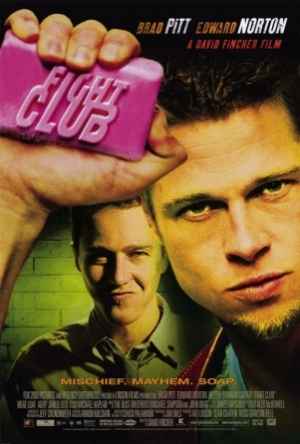
Character traiting depicts Jack’s connection to consumerism, Marla (Helena Bonham Carter), and other men. Doubling examines similarities and differences between Jack and Durden. The narration establishes the lead characters’ recollection of events and Jack’s opinion of everyone in this diegesis. Ultimately, the fight club and Project Mayhem use vandalism to incite chaos whilst stressing the importance of masculinity. Jack, despite becoming a masculine figure, realises that order and capitalism are necessary.
Character Traiting – Jack’s Miserable Existence
Fight Club presents Jack as someone who needs a reason to live, or even someone to look up to, before he can achieve power and self-respect. Characters are clusters of traits that are constructed in relation to the cultural concept they illustrate. In many gothic texts, the exterior elements will reflect the character’s psychological health.
Jack is a skinny man working a dead-end job in an unnamed office. He is an average and unresponsive human surrounded by death on a regular basis. He subtly keeps his company’s secrets to himself; examining how his company’s cars falter and cause multiple deaths. He is a mistreated and stoic individual. The adult male has accepted his place in society. Jack’s low self-esteem has stemmed from cultural expectations of masculinity.
“Addiction is the ‘other side’ of the choice and responsibility which goes with the autonomous development of a self-narrative or identity in circumstances in which traditional guidance has collapsed making lifestyle decisions a potentially dread-full process of ‘making oneself’” (Barker. 230).
This quote points out Jack’s transition from aspirational human being to normalcy. The film presents him as one of thousands of men convinced they are little more than lower/middle class workers. Jack obsession with cleanliness and style diverts him away from desire. His obsession with IKEA furniture subverts the idea of masculinity.
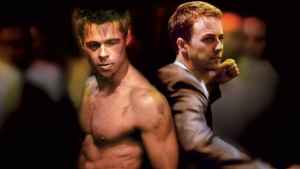
The film establishes Jack’s bond with similarly depressed individuals. Convinced he is sick, he visits group therapy sessions for varying diseases and conditions. The patients, including Bob, represent the men who have lost their masculinity. Whereas Jack lost his masculinity to existential crisis and submissiveness, Bob had his masculinity taken away by disease.
Spending most of their time crying, some of the male characters in this world are reduced to weak individuals. In this world, many of the male characters have either lost or have not discovered the ability to embrace masculinity. Marla Singer (Helena Bonham Carter) represents Jack’s feminine side. Marla is a cunning and smart individual. She utilises her overt sexuality, unique looks, and abrasive personality. At first, he complains about her role as a condescending outsider. However, Marla crawls into his head and proves how important he is. Jack realises the people around him can find purpose and gain self-respect.
Doubling – Jack Meets Durden
With Durden’s help, Jack goes from being weak to finding a new sense of power. Doubles may refer to the duality within one person and represent the polarity between good and evil. Many gothic texts use doubles to illustrate the main character’s shattered state. Lynn M. Ta says that:
“Setting himself apart from the masochistic subject that remains a slave to the economic system, the white male rebel must revolt against a dominant culture that has ostensibly pushed masculinity to the margins.” (Ta. 269)
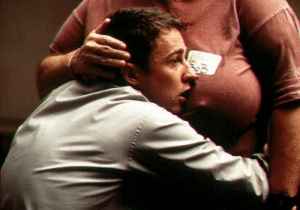
This quote suggests that the male characters, Jack in particular, must overcome adversity. Suffering from continual nightmares, he wishes that he could one day wake up and be someone else. After imagining a plane crash, Jack is introduced to Durden. Unlike Jack, Durden is against commercialism and the optimistic view of the world. In their first meeting, he points out the ridiculousness of air travel safety precautions.
Whereas Jack has accepted his place in society, Durden strives to break the bonds of establishment. Jack is a man who has all but given up on changing the world. When his house his blown up, the material possessions he holds dear are taken away. This incident releases him from conventions and rules. Here, Jack is relating to his masculine side after being exposed to his feminine side (Marla) for an extended period of time.
Jack punishes himself for embracing his feminine side. Staying at Durden’s house, Jack accepts capitalism has weakened his resolve. Durden allows Jack to see beyond the shrinking walls of his office cubicle. Jack and Durden analyse the societal problems stemming from commercialism. Every news story, advertisement, and product is designed to make men into people who fit in, rather than allowing them to embrace their masculinity. Durden believes that fight club’s existence will allow men to embrace their wildest fantasies and become autonomous individuals. By becoming a patriarchal figure for all those involved to worship, Durden becomes a symbol of hope for hard-working and mistreated men. Kim Morgan says that:
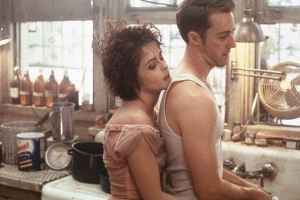
“In the transformation from “Fight Club” to “Project Mayhem”, the members merely shift their anger from each other to the outside world- the soul-deadening culture that has merged new age spirituality with consumerism, hiding dehumanization behind politically correct calm.” (Morgan. 2009)
This quote suggests that Durden’s army must take their anger out on capitalism, after taking it out on each other, in order to make significant cultural change. Durden believes that his new group, later becoming an army for Project Mayhem, can destroy the capitalist/consumer-based elements of culture. Durden is the man he has always wanted to be. Durden claims to be the alpha-male; clamouring for Jack to wake up one day and change his life for the better. He excels when he believes that he is Durden. However, this struggle will ultimately cause chaos and destruction.
Jack and Durden tussle over Jack’s consciousness whilst finding flaws in their commercially-driven world and giving working-class men, even Jack himself, reasons to become autonomous. The narrator’s perspective is an effect of language and cultural assumptions readers/viewers can draw from the text.
Narration – Jack/Durden’s Grip on Reality
Fight Club provides a commentary on the logistics of capitalism’s disruption. The film presents, via narration and narratorial stance, the idea of turning this concept into a reality. Throughout the film, Jack and Durden fight each other for power and for the right to exist. Whereas Jack continually contemplates Durden’s actions, Durden is obsessed with changing existence to suit him. The conflict between anarchy and capitalism, and Jack and Durden, turns Jack’s consciousness/mind into a liminal space. Hart Cohen, Iqbal Barkat, and Juan Francisco Salazar say that:
“The distance and perspective of the narrator – for example, whether the narrator is giving an account of his own life in his own words or whether he is giving an account of himself in the third person – affects the mood of the viewer and the attitude the viewer will adapt to the narrator and the content of the story.” (Cohen, Salazar & Barkat. 35)
This quote suggests narration and narratorial stance can influence the reader/viewer’s perception of the text. Jack turns from a frightened and repressed individual, into a symbol of chaos and redemption for Project Mayhem. He understands his connection with, and eventual disconnection from, the commercial world and Durden’s world. His narration subverts the use of narration in popular texts. He focuses on narration itself and the communication between him and Durden. At one point, when the story returns to the present, Jack and Durden comment on Jack’s narration.
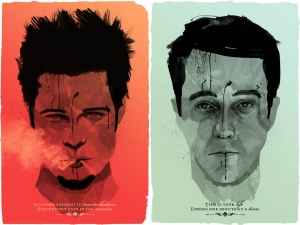
In one scene, Jack and Durden break the fourth wall as they show Durden’s questionable actions. At one point, Durden’s job as a film projectionist is called into question. This flashback scene establishes a small yet vital way of disrupting capitalism. Putting one frame from a porn film into a children’s film breaks the continuity and immersive effect of the film that everyone was enjoying.
This is a metaphor for Durden’s plan of destroying capitalism’s bond with gender neutral entertainment. This scene also illustrates Jack’s power as the narrator. Narrating the events of this story, he is able to dictate which scenes are the most important and why. In the aforementioned scene, we see him and Durden narrating whilst being a part of the setting. This type of narration calls reality and identity into question, whilst separating fact from opinion when discussing Jack and Durden’s plans for world domination.
Conclusion
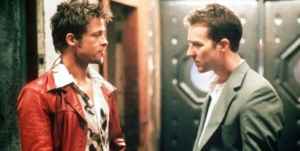
Character traiting is used to illustrate the troubled status of Jack and contemporary masculinity. Jack’s character traits symbolise his attachment to material goods, order, and his feminine side. This textual strategy illustrates how the illusory effects of capitalism may keep men from expressing power and self-respect. Doubles are used to create a contrast between different character types. Jack’s double, Durden, represents both the disruption of capitalism and the enviable male specimen.
The narration depicts Jack’s shattered recollection of this story. Constantly commenting on topics and issues Jack has failed to notice, Durden is depicted as a leader for the lower/middle-class man to idolise. By forming his own group, this patriarchal figure is the right person to cause shifts in capitalism and give men power and self-respect. Once Durden enters his world, Jack begins to feel an internal struggle. Jack and Durden soon fight for control over Jack’s consciousness.
Works Cited
Disclaimer: Curtin University, 2013.
Barkat, Iqbal., Cohen, Hart., and Salazar, Juan Francisco. Screen Media Arts: An Introduction to Concepts and Practices. Oxford University Press: Australia and New Zealand. Melbourne, Australia. 2009. Print.
Barker, Chris. Sex, Subjectivity and Representation. Cultural Studies: Theory and Practice. London, Thousand Oaks, New Delhi: Sage. pp. 224-58; 395-413. 2000. Print.
Fincher, David (director). Fight Club. 20th Century Fox. USA. 139 mins. 1999. Film.
Morgan, Kim. Fight Club Ten Years Later. The Blog. Huffington Post Entertainment. TheHuffingtonPost.com, inc. Retrieved from http://www.huffingtonpost.com/kim-morgan/fight-club-ten-years-late_b_364581.html. 2009. Website.
Ta, Lynn M. Hurt So Good: Fight Club, Masculine Violence, and the Crisis of Capitalism. The Journal of American Culture. Blackwell Publishing inc. Retrieved from http://search.proquest.com.dbgw.lis.curtin.edu.au/docview/200656840/fulltextPDF. p. 265-77. 2006. Website.
What do you think? Leave a comment.











Fight Club is about justice and a complete rejection of conformity. Consumerism, fashion, debt, societal norms – it’s about rejecting anything that diminishes masculinity by enslaving it. What is more masculine than fighting?
He feeds back everything he is being sold, debt, consumerism, behaviour…. That’s the point of making the luxury soap – he sells the rich their fat a**e’s back to them. In the act of destroying the credit card companies – it is an act of emancipation from debt. By rescuing people from the self-help classes, he is liberating them from the victim-hood imposed on them.
It’s about Men being individuals and doing what Men should do – be independent free thinkers ready to challenge anyone, to a fight if neccessary.
Is it still happening? Yes absolutely it is. The media are the biggest purveyors of it.
Plenty have forgotten the first rule of Fight Club.
Nice.
There is an interesting scene in series 1 of the Swedish series Wallander, in which Krister Henriksson (in the title role) poses the question: “explain to me why a woman’s instincts are always described as ‘natural’ while a man’s instincts are described, in the same context, as ‘primitive'”. Conventional femininity is treated in the popular media as something to be nurtured and in tune with: masculinity is sneered at as something to treated with suspicion, even to be reviled, and certainly not to be expressed.
This is the idea that Fight Club taps into: you can create a climate in which a man’s instincts are decried or stigmatised, but you can’t keep them in a box – they will find a way out. Feminists talk endlessly about women making themselves feel ’empowered’. Fight Club is about men looking for the same high.
I always felt like Fight Club’s point was more that withdrawing from conformity just creates a new conformity.
Which is simply a form of reality: there will always be some order.
So I was watching Fight Club for the first time and it was ok. Can´t say I loved it but it had some good twists.
Fincher’s masterpiece is certainly either Fight Club or Se7en I love both so I honestly can’t decide.
When I was 14 watching this, I was in a dark period of my life. I had not been in school for months nor talked to any of my friends. All I did was watching movies and playing WoW in my underwear. Sleeping through the days then wake up at night for my daily dose of entertainment . This fuarking movie hit me so spot on, I left my house for the first time in months, it was raining like hell and it was 2PM at night. I took an old ladies bike and I rode away. I rode until my muscles burned and my veins pumped battery acid. Then I rode some more. Then I stopped and looked up in the dark rainy sky and I roaared with my arms raised up. I felt so alive. It was like that scene in V for Vendetta when Nathalie Portman is let out of the prison and goes out into the rain.
That was 5 years ago and now I just bought a 60″ inch TV for my new apartment, spending money I don’t have on home decor I don’t need. I guess the impact couldn’t last forever. Its a consumer society!
I love this movie, I’ve seen it maybe 100 times!
I thought it was solid up until we find out Tyler isn’t real.
I can’t believe people let this film change their philosophy and world view. It’s a great black comedy, though. I laughed until it hurt.
It’s because there is a good message; that one shouldn’t be what culture says you should be, but, at the same time, go so far in the opposite direction that you end up becoming the very thing you were fighting against. Plus, there’s a lot of little things that you notice after repeated viewings; for example, the way the Space Monkeys in the car start looking uneasy when the Narrator and Tyler start talking, or how Tyler pulls the Narrator out of the car through the driver’s side, when he should be on the passenger’s side.
Besides of course everything else, I remember also falling in love with the movie’s visuals when I saw it many years ago. I haven’t watched in for a while and was expecting that it wouldn’t hold up visually since it’s been nearly 15 since its release, but I still think it’s stunning looking. It’s probably Fincher’s best looking movie, it’s like one long gorgeously shot music video.
I specially love the basement fight scenes, something about the camera work and the cinematography is just unsurpassed.
Fight Club is not about masculinity alone. It is about men who have embraced nihilism and in passionate fury dedicate themselves to the destruction of everything.
David Fincher has made tons of excellent films. Hard to pick a favorite, but personally I go back and forth between Fight Club and The Social Network.
Fight Club is my favourite of the cult films I’ve seen so far.
Bookmarked.
For me, the key takeaway from Fight Club was to not own/buy/accumulate so many *things*. As a woman with a bit of a shopping urge, that takes quite some willpower. ;D
As for the discussion on “manliness”, from my admittedly narrow personal experience, I think that a man’s “natural state of being” can be more aggressive/competitive than I personally as a woman and wife am comfortable with. (Just speaking for myself here, don’t dare to generalise for all womenfolk.) I think there’s a deep unease in the relationship between the prowling hunter-caveman and the hearth that he eventually returns to and feels a sense of responsibility over. To me, that’s the compromise and price that one pays for living in a stable modern society. If you need to form underground fighting rings to let out some of the aggression (or to have a yelling boozy footie session, whatever), I approach it the same way my husband approaches my shopping: I understand your reasons for needing to do it, but I don’t need to know about it in too much detail.
In other words: you don’t talk about Fight Club. 😛
Personally, I think the film is considering the pros and cons of the modern world through themes like commercialisation etc.
Surprised I didn’t see you guys mention jackdurden.com here…probably the best analysis made to date of Fight Club, this was still great though!!
After reading Palahniuk’s recent controversial tumblr comments, I had started thinking a lot about whether Fight Club actually handled these issues as subtly as I had remembered. You’ve convinced me– definitely gotta reread!
The problem is that Norton’s character is right. Deep down, we all know it. ‘That’ is not what a man looks like, and yet the media is attempting suggest that a man should aspire to look like a ponce – against the the will of normal men. Frankly its high time this awful metrosexual / androgynous image of men was consigned to the dustbin of history, remembered as just another fashion anomaly.
I watched this film soon after release, thought nothing of it, other than how predictable and preposterous the plot was. After that I’ve forgotten all about it.
With Marla’s complex character, the stereotypical masculinity of Jack is hidden in Tyler so that he can fulfill what he wants physically while trying to understand himself and his relationships in himself. Masculinity is challenged by the “what is the manly thing to do” question and the “be a man!” joust, so instead of being for or against the whole debate Jack just rides the curve and allows himself to explore both ends.
I’ve seen the movie but I’ve been meaning to read the book also. I’m curious to see how much the film deviated and if it expresses the same ideas.
Great article!